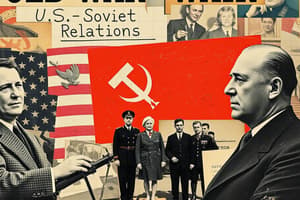Podcast
Questions and Answers
What was the main reason for the US and Soviet Union moving away from aggressive brinkmanship policies in the 1970s?
What was the main reason for the US and Soviet Union moving away from aggressive brinkmanship policies in the 1970s?
- Military defeat
- Diplomatic pressure
- Fear of nuclear war (correct)
- Economic sanctions
What was the main reason for the US and Soviet Union moving away from aggressive brinkmanship policies in the 1970s?
What was the main reason for the US and Soviet Union moving away from aggressive brinkmanship policies in the 1970s?
- Fear of nuclear war
- Nixon's realpolitik philosophy (correct)
- The Strategic Defense Initiative (SDI
- The Helsinki Accords
What philosophy did Nixon follow that replaced brinkmanship with détente?
What philosophy did Nixon follow that replaced brinkmanship with détente?
- Realpolitik (correct)
- Interventionism
- Isolationism
- Idealism
What event caused the early post-war years to be marked by crises and fear of nuclear war?
What event caused the early post-war years to be marked by crises and fear of nuclear war?
Which treaty did Nixon sign with the Soviet Union in 1972?
Which treaty did Nixon sign with the Soviet Union in 1972?
Which countries were visited by Nixon in the 1970s, leading to the signing of the SALT I Treaty?
Which countries were visited by Nixon in the 1970s, leading to the signing of the SALT I Treaty?
What did the Helsinki Accords commit 33 nations to in 1975?
What did the Helsinki Accords commit 33 nations to in 1975?
What was the main purpose of the Helsinki Accords?
What was the main purpose of the Helsinki Accords?
Why was the SALT II agreement not ratified by the US Congress?
Why was the SALT II agreement not ratified by the US Congress?
Why was the SALT II agreement not ratified by the US Congress?
Why was the SALT II agreement not ratified by the US Congress?
What policy did Reagan's presidency see a move away from?
What policy did Reagan's presidency see a move away from?
What was the main effect of Reagan's presidency on US-Soviet relations?
What was the main effect of Reagan's presidency on US-Soviet relations?
What event brought a thaw in the Cold War under Soviet leadership in 1985?
What event brought a thaw in the Cold War under Soviet leadership in 1985?
What caused a thaw in the Cold War during the 1980s?
What caused a thaw in the Cold War during the 1980s?
Flashcards are hidden until you start studying
Study Notes
- In the 1970s, the US and Soviet Union moved away from aggressive brinkmanship policies.
- Early post-war years were marked by crises and fear of nuclear war.
- Détente replaced brinkmanship under Nixon's realpolitik philosophy.
- Nixon visited China in 1972, followed by the Soviet Union, and signed the SALT I Treaty.
- The Helsinki Accords committed 33 nations to détente and cooperation in 1975.
- Carter and Brezhnev signed the SALT II agreement in 1979, but it was not ratified by the US Congress due to concerns over Soviet treatment of protesters and the invasion of Afghanistan.
- Reagan's presidency saw a move away from détente and increased defense spending.
- The Strategic Defense Initiative (SDI) was announced in 1983.
- The US and Soviet Union were pushed further from détente by US activities in Nicaragua.
- A change in Soviet leadership in 1985 brought a new policy toward the US and a thaw in the Cold War.
Studying That Suits You
Use AI to generate personalized quizzes and flashcards to suit your learning preferences.




